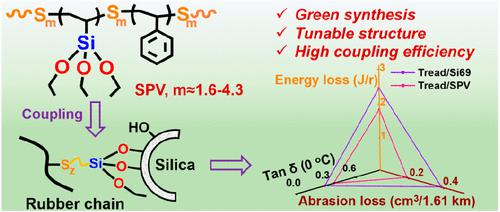当前位置:
X-MOL 学术
›
Macromolecules
›
论文详情
Our official English website, www.x-mol.net, welcomes your
feedback! (Note: you will need to create a separate account there.)
Inverse Vulcanization of Vinyltriethoxysilane: A Novel Interfacial Coupling Agent for Silica-Filled Rubber Composites
Macromolecules ( IF 5.1 ) Pub Date : 2022-10-02 , DOI: 10.1021/acs.macromol.2c01678 Dong Wang 1 , Zhenghai Tang 1 , Ruoyan Huang 1 , Haoming Li 1 , Chengfeng Zhang 1 , Baochun Guo 1
Macromolecules ( IF 5.1 ) Pub Date : 2022-10-02 , DOI: 10.1021/acs.macromol.2c01678 Dong Wang 1 , Zhenghai Tang 1 , Ruoyan Huang 1 , Haoming Li 1 , Chengfeng Zhang 1 , Baochun Guo 1
Affiliation

|
Sulfur-containing silane coupling agents (SSCAs) are widely incorporated into silica-filled rubber composites to improve silica dispersion and enhance interfacial adhesion, maximizing the potential of silica. However, SSCA synthesis involves multistep procedures and requires organic solvents. In addition, modifying rubber composites with SSCAs has persistent issues, such as low coupling efficiency and uncontrollable structure. Herein, we report the facile synthesis of alkoxysilyl-functionalized polysulfides (SPVs) with a tunable molecular structure (sulfur rank and alkoxysilyl fraction) via inverse vulcanization of vinyltriethoxysilane (VTES) with a copolymer of sulfur and styrene. SPVs serve as interfacial modifiers in silica-filled rubber composites by separately reacting with the silica and rubber chains. In particular, the multiple alkoxysilyl sites in the SPV chain increase the probability of silanization, yielding high coupling efficiency in the rubber composite. Although the molar content of alkoxysilyl groups in SPV1 (the mass feed ratio of VTES and copolymer is 1) is half of that in the most widely used small-molecules SSCAs of bis(3-triethoxysilylpropyl)tetrasulfide, stronger interfacial adhesion and better silica dispersion are achieved in SPV1-modified composites, which consequently lead to more improvements on the composite properties. In addition, the advantages of SPV1 as an interfacial modifier in improving the “magic triangle” properties of a practical tread composite have been demonstrated. More importantly, the effects of the SPV molecular structure on silica dispersion and interfacial adhesion have been investigated, providing the fundamentals for unraveling the coupling mechanism and guiding composite property regulation.
中文翻译:

乙烯基三乙氧基硅烷的反硫化:二氧化硅填充橡胶复合材料的新型界面偶联剂
含硫硅烷偶联剂 (SSCA) 广泛掺入二氧化硅填充橡胶复合材料中,以改善二氧化硅分散性和增强界面粘附力,最大限度地发挥二氧化硅的潜力。然而,SSCA 合成涉及多步程序并且需要有机溶剂。此外,用SSCAs改性橡胶复合材料存在耦合效率低、结构不可控等问题。在此,我们报告了通过乙烯基三乙氧基硅烷 (VTES) 与硫和苯乙烯的共聚物的反向硫化,轻松合成具有可调分子结构(硫等级和烷氧基甲硅烷基部分)的烷氧基甲硅烷基官能化多硫化物 (SPV)。SPV 通过分别与二氧化硅和橡胶链反应,在二氧化硅填充橡胶复合材料中用作界面改性剂。尤其是,SPV 链中的多个烷氧基甲硅烷基位点增加了硅烷化的概率,从而在橡胶复合材料中产生了高偶联效率。虽然SPV1中的烷氧基甲硅烷基摩尔含量(VTES与共聚物的质量进料比为1)是最广泛使用的双(3-三乙氧基甲硅烷基丙基)四硫化物小分子SSCA的一半,但界面附着力更强,二氧化硅分散性更好在 SPV1 改性复合材料中实现了,从而导致复合材料性能的更多改进。此外,SPV1 作为界面改性剂在改善实际胎面复合材料的“魔三角”性能方面的优势已得到证实。更重要的是,研究了 SPV 分子结构对二氧化硅分散和界面附着力的影响,
更新日期:2022-10-02
中文翻译:

乙烯基三乙氧基硅烷的反硫化:二氧化硅填充橡胶复合材料的新型界面偶联剂
含硫硅烷偶联剂 (SSCA) 广泛掺入二氧化硅填充橡胶复合材料中,以改善二氧化硅分散性和增强界面粘附力,最大限度地发挥二氧化硅的潜力。然而,SSCA 合成涉及多步程序并且需要有机溶剂。此外,用SSCAs改性橡胶复合材料存在耦合效率低、结构不可控等问题。在此,我们报告了通过乙烯基三乙氧基硅烷 (VTES) 与硫和苯乙烯的共聚物的反向硫化,轻松合成具有可调分子结构(硫等级和烷氧基甲硅烷基部分)的烷氧基甲硅烷基官能化多硫化物 (SPV)。SPV 通过分别与二氧化硅和橡胶链反应,在二氧化硅填充橡胶复合材料中用作界面改性剂。尤其是,SPV 链中的多个烷氧基甲硅烷基位点增加了硅烷化的概率,从而在橡胶复合材料中产生了高偶联效率。虽然SPV1中的烷氧基甲硅烷基摩尔含量(VTES与共聚物的质量进料比为1)是最广泛使用的双(3-三乙氧基甲硅烷基丙基)四硫化物小分子SSCA的一半,但界面附着力更强,二氧化硅分散性更好在 SPV1 改性复合材料中实现了,从而导致复合材料性能的更多改进。此外,SPV1 作为界面改性剂在改善实际胎面复合材料的“魔三角”性能方面的优势已得到证实。更重要的是,研究了 SPV 分子结构对二氧化硅分散和界面附着力的影响,


















































 京公网安备 11010802027423号
京公网安备 11010802027423号